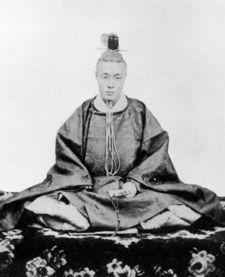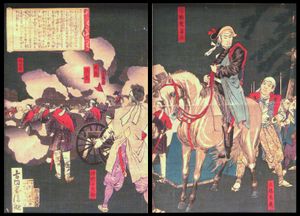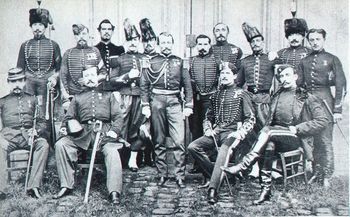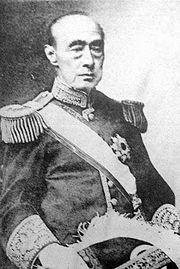Tokugawa Yoshinobu
- In this Japanese name, the family name is Tokugawa.
| Tokugawa Yoshinobu | |
 Tokugawa Yoshinobu as Shogun of Japan, c. 1867 |
|
|
15th Edo Shogun
|
|
|---|---|
| In office 1867–1868 |
|
| Preceded by | Tokugawa Iemochi |
| Succeeded by | none (shogunate abolished)[1] |
|
|
|
| Born | October 28, 1837 Mito, Ibaraki, Japan |
| Died | November 22, 1913 (aged 76) Bunkyō, Tokyo, Japan |
| Nationality | Japanese |
Tokugawa Yoshinobu (徳川 慶喜) (also known as Keiki), October 28, 1837–November 22, 1913) was the 15th and last shogun of the Tokugawa shogunate of Japan. He was part of a movement which aimed to reform the aging shogunate, but was ultimately unsuccessful. After resigning in late 1867, he went into retirement, and largely avoided the public eye for the rest of his life.
Contents |
Early life
Tokugawa Yoshinobu was born in Mito, Hitachi Province, the seventh son of Tokugawa Nariaki, daimyo of Mito. Mito was one of the gosanke, the three branch families of the Tokugawa clan which were eligible to be chosen as shogun.
Born with the name Matsudaira Shichirōma[2], he was brought up under strict, spartan supervision and tutelage[3]. He was taught in the literary and martial arts, as well as receiving a solid education in the principles of politics and government.[4]
At the instigation of his father, Shichirōma was adopted by the Hitotsubashi-Tokugawa family in order to have a better chance of succeeding to the shogunate.[5] He became family head in 1847, coming of age that year, receiving court rank and title, and taking the name Yoshinobu.[6] Upon the death of the 13th shogun, Shogun Iesada, in 1858, Yoshinobu was nominated as a potential successor.[7] His supporters touted his skill and efficiency in managing family affairs. However, the opposing faction, led by Ii Naosuke, won out. Their candidate, the young Tokugawa Yoshitomi, was chosen, and became the 14th shogun Iemochi.[8] Soon after, during the Ansei Purge, Yoshinobu and others who supported him were placed under house arrest.[9] Yoshinobu himself was made to retire from Hitotsubashi headship.

The period of Ii's domination of the Tokugawa government was marked by mismanagement and political infighting. Upon Ii's assassination in 1860, Yoshinobu was reinstated as Hitotsubashi family head, and was nominated in 1862 to be the shogun's guardian (将軍後見職 shōgun atomi-shoku), receiving the position soon afterwards.[10] At the same time, his two closest allies, Matsudaira Yoshinaga and Matsudaira Katamori, were appointed to other high positions: Yoshinaga as chief of political affairs (政治総裁職 seiji sōsai shoku)[11], Katamori as Guardian of Kyoto (京都守護職 Kyoto Shugoshoku)[12]. The three men then took numerous steps to quell political unrest in the Kyoto area, and gathered allies to counter the activities of the rebellious Chōshū Domain. They were instrumental figures in the kōbu-gattai political party, which sought a reconciliation between the shogunate and the imperial court.[13]
In 1864, Yoshinobu, as commander of the imperial palace's defense, successfully defeated the Chōshū forces in their attempt to capture the imperial palace's Hamaguri Gate. This was achieved by use of the forces of the Aizu-Satsuma coalition.[14]
Shogun Yoshinobu (1866)
After the death of Tokugawa Iemochi in 1866, Yoshinobu was chosen to succeed him, and became the 15th shogun.[15] He was the only Tokugawa shogun to spend his entire tenure outside of Edo; he would never set foot in Edo Castle as shogun[16].

Immediately upon Yoshinobu's ascension as shogun, major changes were initiated. A massive government overhaul was undertaken to initiate reforms that would strengthen the Tokugawa government. In particular, assistance from the Second French Empire was organized, with the construction of the Yokosuka arsenal under Leonce Verny, and the dispatch of a French military mission to modernize the armies of the bakufu.[17]
The national army and navy, which had already been formed under Tokugawa command, were strengthened by the assistance of the French, and military equipment was also purchased from the United States.[18] The outlook among many was that the Tokugawa shogunate was gaining ground towards renewed strength and power; however, it would fall in less than a year.
Boshin War (1867–1869)
Fearing the renewed strengthening of the Tokugawa shogunate under a strong and wise ruler, samurai from Satsuma, Chōshū and Tosa formed an alliance to counter it. Under the banner of sonnō jōi ("revere the Emperor, expel the barbarians!") coupled with a fear of the new Shogun as the "Rebirth of Ieyasu" who would continue to usurp the power of the Emperor, they worked to bring about an end to the shogunate, though they varied in their approaches. In particular, Tosa was more moderate; it proposed a compromise whereby Yoshinobu would resign as shogun, but preside over a new national governing council composed of various daimyo. To this end, Yamauchi Toyonori, the lord of Tosa, together with his advisor, Gotō Shōjirō, petitioned Yoshinobu to resign[19] in order to make this possible.
Yoshinobu stepped down as shogun in late 1867, formally returning governing power to the Emperor.[20] He then withdrew from Kyoto to Osaka. However, Satsuma and Chōshū, while supportive of a governing council of daimyo, were opposed to Yoshinobu leading it.[19] They secretly obtained an imperial edict[19]calling for the use of force against Yoshinobu (later shown to be a forgery[21]) and moved a massive number of Satsuma and Chōshū troops into Kyoto.[22] There was a meeting called at the imperial court, where Yoshinobu was stripped of all titles and land[23], despite having taken no action that could be construed as aggressive or criminal. Any who would have opposed this were not included in the meeting.[22] Yoshinobu opposed this action, and composed a message of protest, to be delivered to the imperial court[24]; at the urging of men of Aizu, Kuwana, and other domains, and in light of the immense number of Satsuma and Chōshū troops in Kyoto, he dispatched a large body of troops to convey this message to the court.[25]
When the Tokugawa forces arrived outside Kyoto, they were refused entry, and were attacked by Satsuma and Choshu troops, starting the Battle of Toba-Fushimi, the first clash of the Boshin War.[26] Though the Tokugawa forces had a distinct advantage in numbers, Yoshinobu abandoned his army in the midst of the fight once he realized the Satsuma and Choshu forces raised the Imperial banner, and escaped to Edo[27]. He placed himself under voluntary confinement, and indicated his submission to the imperial court. However, a peace agreement was reached wherein Tayasu Kamenosuke, the young head of a branch of the Tokugawa family, was adopted and made Tokugawa family head[28]; Edo Castle was handed over to the imperial army[29], and the city spared from all-out war.
Together with Kamenosuke (who took the name Tokugawa Iesato), Yoshinobu moved to Shizuoka, the place to which Tokugawa Ieyasu, founder of Tokugawa shogunate, had also retired, centuries earlier. Iesato was made the daimyō of the new Shizuoka Domain, but lost this title a few years later, when the domains were abolished.
Many of the hatamoto also relocated to Shizuoka; a large proportion of them did not find adequate means to support themselves. As a result, many of them resented Yoshinobu, some of them to the point of wanting him dead.[30] Yoshinobu was aware of this, and was so afraid of assassination that he redesigned his sleeping arrangement to confuse a potential assassin.[31]
Later life

Living a life in quiet retirement, Yoshinobu indulged in many hobbies, including oil-painting, archery, hunting, photography, and even cycling.[32] Some of Yoshinobu's photographs have been published in recent years by his great-grandson, Yoshitomo.[33]
In 1902, the Meiji Emperor allowed him to reestablish his own house as a Tokugawa branch (bekke) with the highest rank in the peerage, that of prince (kōshaku), for his loyal service to Japan.[34] Tokugawa Yoshinobu [peer] died on November 21, 1913 at 4:10 pm and he is buried in Yanaka Cemetery of Tokyo .
His ninth daughter Tokugawa Tsuneko (1882-1939), married Prince Fushimi Hiroyasu {a second cousin to both Emperor Shōwa (Hirohito) and Empress Kōjun, and nephew of Prince Kan'in Kotohito} on 9 January 1896.
Honors
- Order of the Rising Sun, Grand Cordon, 1908.[35]
Eras of Yoshinobu's bakufu
The years in which Yoshinobu was Shōgun are more specifically identified by more than one era name or nengō.
- Keiō (1865-1868)
- Meiji (1868-1912)
See also
- Late Tokugawa shogunate
- Meiji Restoration
- Tokugawa Yoshinobu-ke
Notes
- ↑ Takano, Tokugawa Yoshinobu, p. 257.
- ↑ Takano, Tokugawa Yoshinobu, p. 26. Sons of the lord of Mito did not bear the name Tokugawa unless they themselves became the next lord.
- ↑ Tokugawa, Tokugawa yonbyakunen no naishobanashi, pp. 138-140.
- ↑ Takano, p. 28.
- ↑ Takano, p. 38.
- ↑ Takano, p. 48.
- ↑ Borton, Japan's Modern Century, p. 40.
- ↑ Borton, pp. 39-40.
- ↑ Takano, pp. 12-13.
- ↑ Murray, Japan, p. 362; Kobiyama, Matsudaira Katamori no shōgai, p. 75; Bolitho, Collapse of the Tokugawa Bakufu, p. 9.
- ↑ Kobiyama, p. 75.
- ↑ Takano, pp. 132-133.
- ↑ Kobiyama, pp. 84-87; Totman, p. 45; Takano, p. 20.
- ↑ See Japan 1853-1864, Or, Genji Yume Monogatari, trans. by Ernest Mason Satow. (Tokyo: Naigai Shuppan Kyokai), for more.
- ↑ Borton, p. 63.
- ↑ Tokugawa, Tokugawa yonbyakunen no naishobanashi, vol. 2, p. 162.
- ↑ Sims, French Policy Towards the Bakufu and Meiji Japan, 1854-95, p. 236.
- ↑ Treat, Japan and the United States: 1853-1921, p. 89
- ↑ 19.0 19.1 19.2 Beasley, The History of Modern Japan, p. 96.
- ↑ Takano, p. 256.
- ↑ Yamakawa, Aizu Boshin Senshi, pp. 7-9.
- ↑ 22.0 22.1 Beasley, p. 97.
- ↑ Beasley, p. 97; Yamakawa, Aizu Boshin Senshi, p. 148-151.
- ↑ Totman, p. 416. For a copy of the original text of the message, see Yamakawa, pp. 89-90.
- ↑ Totman, p. 417.
- ↑ Sasaki, pp. 23-24; Bolitho, pp. 420-422.
- ↑ Kobiyama, p. 124.
- ↑ Griffis, The Mikado: Institution and Person, p. 141.
- ↑ Takano, p. 267.
- ↑ Tokugawa Munefusa, Tokugawa yonbyakunen no naisho banashi, vol. 1, p. 131
- ↑ Tokugawa, pp. 131-133
- ↑ Tokugawa, p. 136-138.
- ↑ For an example of Yoshinobu's photography, see: Tokugawa Yoshitomo, Tokugawa Yoshinobu-ke e yōkoso, p. 73.
- ↑ Takano, p. 273.
- ↑ Ibaraki Prefecture e-newsletter
References
- Beasley, W.G. (1963). The modern history of Japan. (New York: Praeger).
- Borton, Hugh (1955). Japan's Modern Century. (New York: The Ronald Press Company).
- Griffis, William E. (1915). The Mikado: Institution and Person. (Princeton: Princeton University Press).
- Kobiyama Rokurō (2003). Matsudaira Katamori no shōgai. (Tokyo: Shin Jinbutsu Ōraisha).
- Murray, David (1905). Japan. (New York: G.P. Putnam's Sons).
- Sasaki Suguru (1977). Boshin sensō. (Tokyo: Chūōkōron-shinsha).
- Sims, Richard L. (1998). French Policy Towards the Bakufu and Meiji Japan, 1854-95. (London: Routledge).
- Takano Kiyoshi 高野澄 (1997). Tokugawa Yoshinobu: kindai Nihon no enshutsusha 德川慶喜 : 近代日本の演出者. (Tokyo: Nihon Hōsō Shuppan Kyōkai 日本放送出版協会).
- Tokugawa Munefusa 徳川宗英 (2004). Tokugawa Yonhyaku-nen no naisho-banashi 徳川四百年の内緒話 Vol. 1. (Tokyo: Bungei-shunju).
- Tokugawa Munefusa 徳川宗英 (2004). Tokugawa Yonhyaku-nen no naisho-banashi 徳川四百年の内緒話 Vol. 2: Raibaru tekishō hen. (Tokyo: Bungei-shunju).
- Tokugawa Yoshitomo 徳川慶朝 (2003). Tokugawa Yoshinobu-ke ni Yōkoso: Wagaya ni tsutawaru aisubeki "Saigo no Shogun" no Yokogao 徳川慶喜家にようこそ わが家に伝わる愛すべき「最後の将軍」の横顔. (Tokyo: Bungei-shunju). ISBN 4-16-765680-9
- Totman, Conrad (1980). The Collapse of the Tokugawa Bakufu, 1862-1868. (Honolulu: University of Hawai'i Press)
- Treat, Payson J. (1921). Japan and the United States: 1853-1921. (New York: Houghton Mifflin Company).
- Yamakawa Kenjirō (1933). Aizu Boshin Senshi. (Tokyo: Tokyo Daigaku Shuppankai).
Further reading
- Matsuura Rei 松浦玲 (1975). Tokugawa Yoshinobu: shōgun-ke no Meiji-ishin 德川慶喜 : 将軍家の明治維新. (Tokyo: Chūōkōronsha 中央公論社).
- Satow, Ernest M., trans. (1905). Japan 1853-1864, Or, Genji Yume Monogatari. (Tokyo: Naigai Shuppan Kyokai).
- Shibusawa Eiichi 渋沢栄一, ed. (1967-1968) Tokugawa Yoshinobu-kō den 德川慶喜公伝. (Tokyo: Heibonsha 平凡社).
Works of fiction:
- Shiba, Ryōtarō (1998). The Last Shogun: The Life of Tokugawa Yoshinobu, trans. Juliet Winters Carpenter. (New York: Kodansha International). ISBN 1-56836-246-3
| Military offices | ||
|---|---|---|
| Preceded by Tokugawa Iemochi |
15th Tokugawa shogunate: Tokugawa Yoshinobu 1867-1868 |
Succeeded by Shogunate ended |
| Japanese royalty | ||
| Preceded by Tokugawa Shōmaru |
Hitotsubashi-Tokugawa family head 1847-1866 |
Succeeded by Tokugawa Mochiharu |
| Preceded by Tokugawa Iemochi |
Tokugawa family head 1867-1868 |
Succeeded by Tokugawa Iesato |
| Preceded by none |
Tokugawa Yoshinobu-ke Head 1902-1913 |
Succeeded by Tokugawa Yoshihisa |
|
||||||||
|
|||||||||||||||||||||||||||||||||||||||||||||||
|
|||||||||||||||||||||||||||||||||||||||||||||||||||||||||||||||||||||||||||||||||||||||||||||||||||||||||||||||||||||||||||||||||||||||||||||||||||||||||||||||||||||||||||||||||||||||||||||||||||||||||||||||||||||||||||||||||||||||||||||||||||||||||||||||||||||||||||||||||||||||||||||||||||||||||||||||||||||||||||||||||||||||||||||||||||||||||||||||||||||||||||||||||||||||||||||||||||||||||||||||||||||||||||||||||||||||||||||||||||||||||||||||||||||||||||||||||||||||||||||||||||||||||||||||||||||||||||||||||||||||||||||||||||||||||||||||||||||||||||||||||||||||||||||||||||||||||||||||||||||||||||||||||||||||||||||||||||||||||||||||||||||||||||||||||||||||||||||||||||||||||||||||||||||||||||||||||||||||||||||||||||||||||||||||||||||||||||||||||||||||||||||||||||||||||||||||||||||||||||||||||||||||||||||||||||||||||||||||||||||||||||||||||||||||||||||||||||||||||||||||||||||||||||||||||||||||||||||||||||||||||||||||||||||||||||||||||||||||||||||||||||||||||||||||||||||||||||||||||||||||
|
||||||||||||||||||||||||||||||||||||||